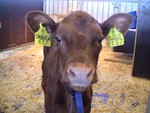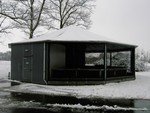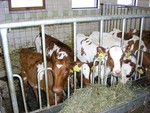
| Outcomes of Nasek / Improving animal welfare / Health and fertility / Calves | Wednesday 11.2.2009 |
|
Calves "Calves are the dairy cows of tomorrow" This important sentence farmers should always keep in mind when they think about calves' housing. It is very important to take care of their welfare, too. Calves have the same rights and demands as dairy cows. They should have enough space, company of other animals of the same kind, a proper stable with light and enough fresh air and a good diet. This is very important since young calves are very susceptible for infections and diseases. It is difficult to raise a healthy and fertile dairy cow with a good milk performance out of a calf who already has problems since her birth. And that´s why we mentioned calf breeding as an important part of "Health and fertility"
There are different systems for the housing of calves and young cattle: One calf systems (most of the time only used for young calves) Iglo-box Calf box Group systems Loose stall stable with lying boxes Systems like iglo-boxes or calf boxes are also used for more calves.
Problems 1. The best place in the stable for young cattle. The youngest calves are often in the same stables as the heifers and the dairy cows. This is a very common system, but it is not optimal for calf breeding. Another problem is that there is often bad air condition and too high temperatures in the stable. The air in the stable smells like ammonia. It would be ideal for a calf to grow in fresh and healthy environment. Bad ventilation might be one of the reasons if calves get ill. In stables with damp and warm air there are more bacterias. A good stable has no windy feeling inside and it is clean and dry; cold air is not bad for a young calf. Another very common problem is light. Stables for young cattle are most of the time in a dark place. And they need the light in the same way as adult cows do. Especially for heifers enough light is important for the reproductive development. 2. Stable and lying areas for young cattle. Another issue worth thinking about in some stables is the laying areas for young calves; in few stables there is nothing on a bottom of laying areas. The bones of young calves are still soft for the first weeks; they need a soft bottom for lying down and walking. The hard bottom from a walking stable is not optimal for the health of the young calves. From three till four months age, the calves are old enough to live in a walking stable, with boxes and a hard floor.
Solutions 1. The best place in the stable for young cattle. The best place for young calves is a stable with healthy and fresh air. The best solution is to keep the calves in another room than the cows. The warm and possibly unhealthy air can’t come into the same stable where the calves live. So maybe a better stable for young cattle is separated from the cows, till they are almost one year old. The air in the stable shouldn’t be too warm and there shouldn’t be feel windy inside. Best solution for light are stables outside or open front stables. It is also possoble to keep them in similar stables like cows, but there should be enough light available (light plates, daylight-lamps,...) 2. Stable and lying areas for young cattle. Stables with for example enough straw, turf or sawdust have the best laying and walking area’s for young calves. It’s also possible that there are two different parts in the stable for the calves; one side for laying and sleeping, with enough bedding material on the bottom. The best place for this part is in the backside of the stable (like a laying area in a free range stable) and in the front side there is a walking space from a small sized slatted floor (special young cattle sizes) and the feeding fence. It’s also possible to fill up the whole stable with enough bedding material.
Here you can also find some rules about housing: "Rules"
Back to "Health and fertility" Page updated 23.5.2006 |
|




